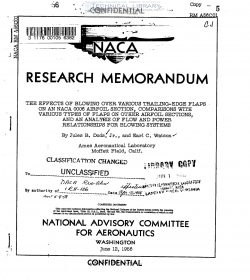naca-rm-a56c01
- Version
- 68 Downloads
- 4.45 MB File Size
- 1 File Count
- October 9, 2017 Create Date
- October 9, 2017 Last Updated
National Advisory Committee for Aeronautics, Research Memorandum - The Effects of Blowing Over Various Trailing Edge Flaps on an NACA 0006 Airfoil Section , Comparisons with Various Types of Flaps on Other Airfoil Sections, and an Analysis of Flow and Power Relationships for Blowing Systems

The investigation reported herein consists of three phases:
(1) an experimental investigation of a thin airfoil with blowing over a
trailing-edge flap; (2) a comparison of the results of the experimental
investigation with the results of other similar investigations; and
(3) a theoretical study of the relationships among the air-flow and
power parameters for the general blowing case.
The experimental investigation employed a two—dimensional model of
the NACA 0006 airfoil equipped with a nose flap and six alternate
trailing-edge flaps. The blowing slot was in the body of the airfoil
ahead of the trailing-edge flap. Only subcritical blowing pressure
ratios could be investigated. Lift, pitching moment, and chordwise
distribution of pressure were measured over a range of angles of attack
for Reynolds numbers from 2.3 million to h million. The variables inves-
tigated include flap position and contour, nozzle height, and blowing
quantity.
The comparison and evaluation phase of the investigation used data
from this experimental investigation together with those obtained from
other investigations which employed thicker airfoil sections. Several
relationships for evaluating the effects of blowing are presented. The
increments of lift coefficient which were obtained with the 6-percent-
thick airfoil of the present investigation compared favorably with those
obtained with the thicker airfoils of the other investigations. It was
found that for flap deflection up to 600 or 70°, the theoretical incre-
ment of lift coefficient due to flap deflection alone (i.e., without
blowing) could be attained or exceeded, depending on the blowing quantity.
The power and flow quantities that may be required of a blowing
system were shown to vary greatly, depending on the arrangement of the
flap and blowing system.
The results of the theoretical study of the air flow and power
relationships are presented in chart form and are applicable to blowing
systems employing either subcritical or supercritical pressure ratios.
| File | Action |
|---|---|
| naca-rm-a56c01 The Effects of Blowing Over Various Trailing Edge Flaps on an NACA 0006 Airfoil Section , Comparisons with Various Types of Flaps on Other Airfoil Sections, and an Analysis of Flow and Power Relationships for Blowing Systems.pdf | Download |
Comment On This Post